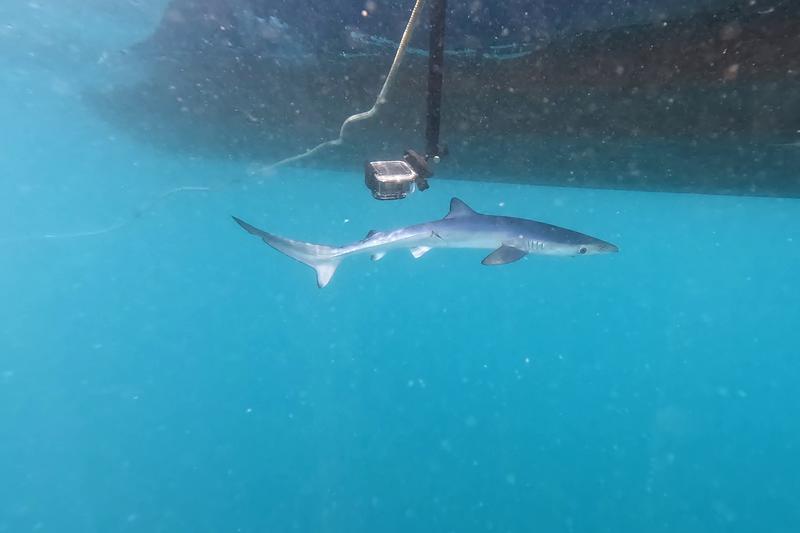Research confirms Cap de Creus as 'stable' blue shark breeding area
Around 10 newborn sharks found in northern Catalan waters between spring and August 2023

The North Catalan canyon of Cap de Creus is a “stable” zone to breed blue sharks, a species in danger of extinction. This is the conclusion of the latest shark studies, carried out by the Catalan Department for Climate Action and the Sotamar Diving Center in Cadaqués.
In the months between late spring and mid-August, the study observed around 90 blue sharks in the waters, ten of which were newborns measuring between 35 and 45 centimeters.
The studies also show that the births primarily occur between mid-June and July. Once the sharks are born, they can take care of themselves on their own.
From hobby to research project
The project was started in 2018 and 2019 by Jordi Riera, manager of the Sotamar Diving Center. Riera has been a shark and diving enthusiast for many years and began to make sporadic diving trips to see if there were any sharks in the area around Cap de Creus.
He spotted the first few sharks between 2020 and 2021, but it wasn’t until 2022 that he decided to make a serious study, teamed up with two biologists, and started going on dives more regularly.
Between April and September, Riera made a total of 54 trips using fish guts to attract sharks, and in June and July he saw more than 60 sharks, most of them pups or juveniles. This indicated that Cap de Creus was a breeding ground for sharks, which are on the endangered species list.
After the research project attracted the interest of the scientific community and the Catalan Department of Climate Action, a collaboration began in 2023.
From late spring to mid-August more than 50 trips took place and around 10 pups were observed out of a total of 90 blue sharks.
“Extraordinary” data
According to Jordi Ruiz, head of invasive species and conservation projects at the Department of Climate Action, the data collected is “extraordinary”.
“The gestation period of sharks is 12 months, so when they come here, two things coincide: births and reproduction,” Ruiz explains. “This means that we have them here during a period that is very important for them,” he adds.
Their breeding takes place in “very specific” places. “When we look at the data, small sharks never appear because they grow up in particular places in the Mediterranean Sea,” says Ruiz. “Having registered 10 is a lot.”
Working together to broaden knowledge
Now, the department wants to expand its knowledge about the sharks' movements and behavior by monitoring them from boats using bate and doing direct observation. This will allow the team to develop a census system and year-to-year monitoring because after the sharks are born, they disappear around mid-July.
“Nine out of ten sharks we haven’t seen again,” says Ruiz. The team doesn't know if they hide in deeper water or move to other areas after the first few weeks of life, and now they want to study that.
To do so, the Department of Climate Action has begun collaborating with the Institute of Marine Sciences at the University of Barcelona, the University of Girona, the organization CatShark, and the Barcelona Zoo Foundation, which are the few groups currently working with sharks in Catalonia.
The second phase of the study will start in 2024 and has a price tag of €50,000.
The idea is to continue the census, mark some of the sharks, and take tissue samples. “We want to see the movements of the sharks that breed here and see where they live because we are starting to see that the biggest risks, they have for their survival may be outside of the Catalan waters,” explains Ruiz.
Live in deep waters
At the moment, most of the information they have about the sharks comes from fishing activities and has little to do with animals observed in their natural habitat, which for the Catalan blue shark is deep water.
A study by European scientists from different countries, who tagged dozens of sharks with satellite transmitters showed that it was very unusual for blue sharks to get close to waters that are less than 100 meters deep.
This means that the sharks that sometimes come close to the beaches are either injured, sick, or dead.
The observations made in the Cap de Creus canyon have always taken place in between 200 to 500 meters depth: “When we've done it closer to the coast, we haven’t seen them,” says Ruiz.
Canyon rich in nutrients
Why do sharks breed in the Cap de Creus canyon? According to the researchers, the Gulf of Lions, which stretches from northern Catalonia to southern France, is a preferred bay for this particular species of shark.
“It’s an area with a sharp landform that gives them the possibility of finding food, protection from predators, and it’s rich in nutrients,” explains Ruiz.
This combination makes it a good place to breed because once the pups are born, they can easily find food.
Conservation responsibility
“Now that we know that the Cap de Creus canyon is an important place for blue sharks, not only in Catalonia but in the western Mediterranean Sea, we have a great responsibility to conserve the area,” says Ruiz.
These efforts will be carried out by involving professional and recreational fishermen to avoid accidentally catching the sharks.
An endangered species
The blue shark is one of the 70 species of sharks and rays living in the Mediterranean Sea.
In Catalan waters, there are 26 species of sharks, and many of them are either in danger of extinction or in a critical state, which is the case of the blue sharks, according to 2020 data collected by the Department for Climate Action from a census study made by the organization CatShark.